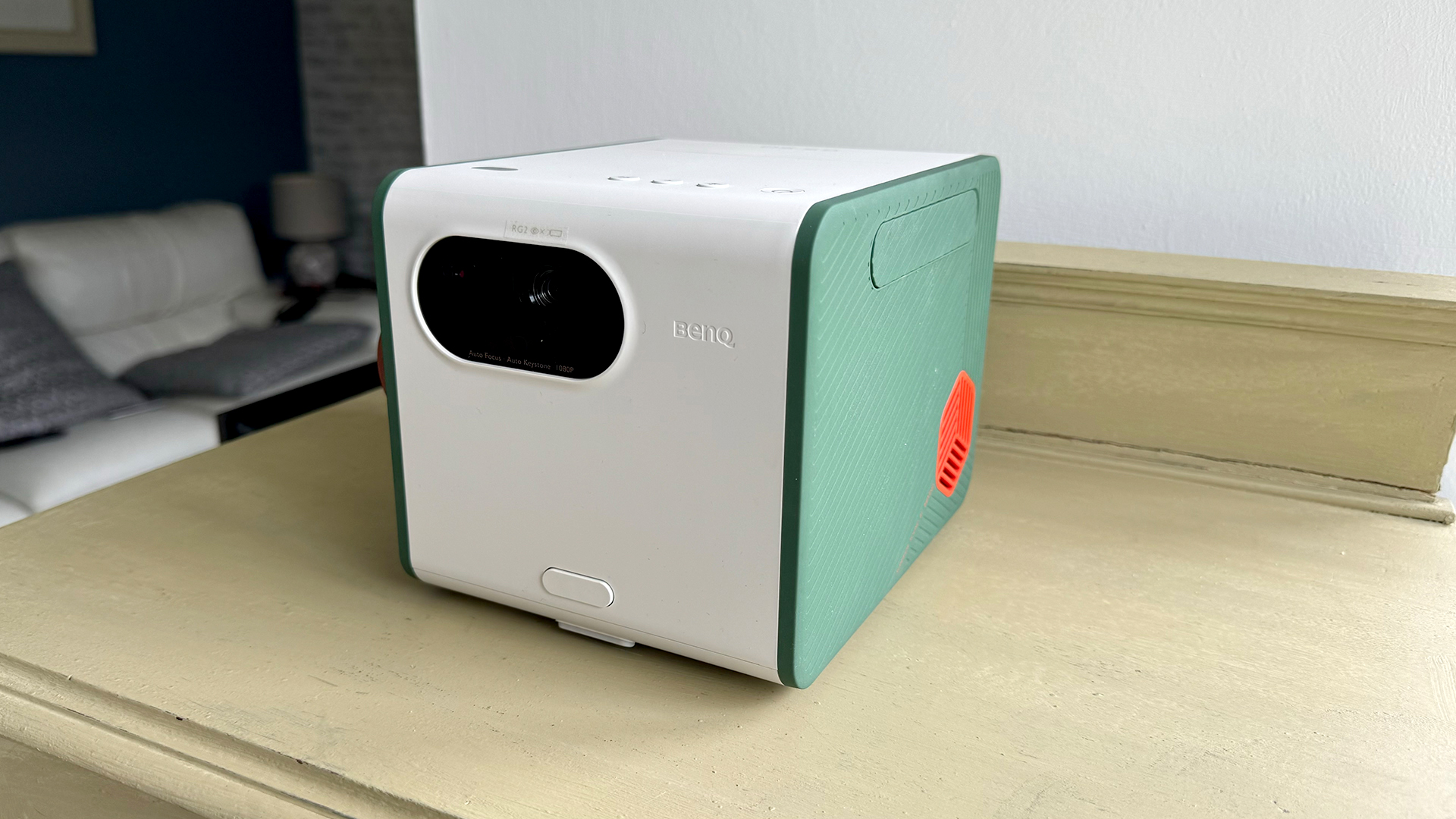
Forget ‘sun’s out, guns out’. Our idea of celebrating the occasional glimmer of summer is to finally emerge squinting and blinking from our home cinema and hi-fi caves with some way of continuing to enjoy our AV hobby tucked under our arms.
Cue the BenQ GS50. This portable projector is not only designed to easily be moved between different mates’ houses for each new sporting event, but can even be used outside, in your back garden, say, or while camping in the great outdoors. Why tell scary stories around the campfire when you can watch a scary film instead?
Price
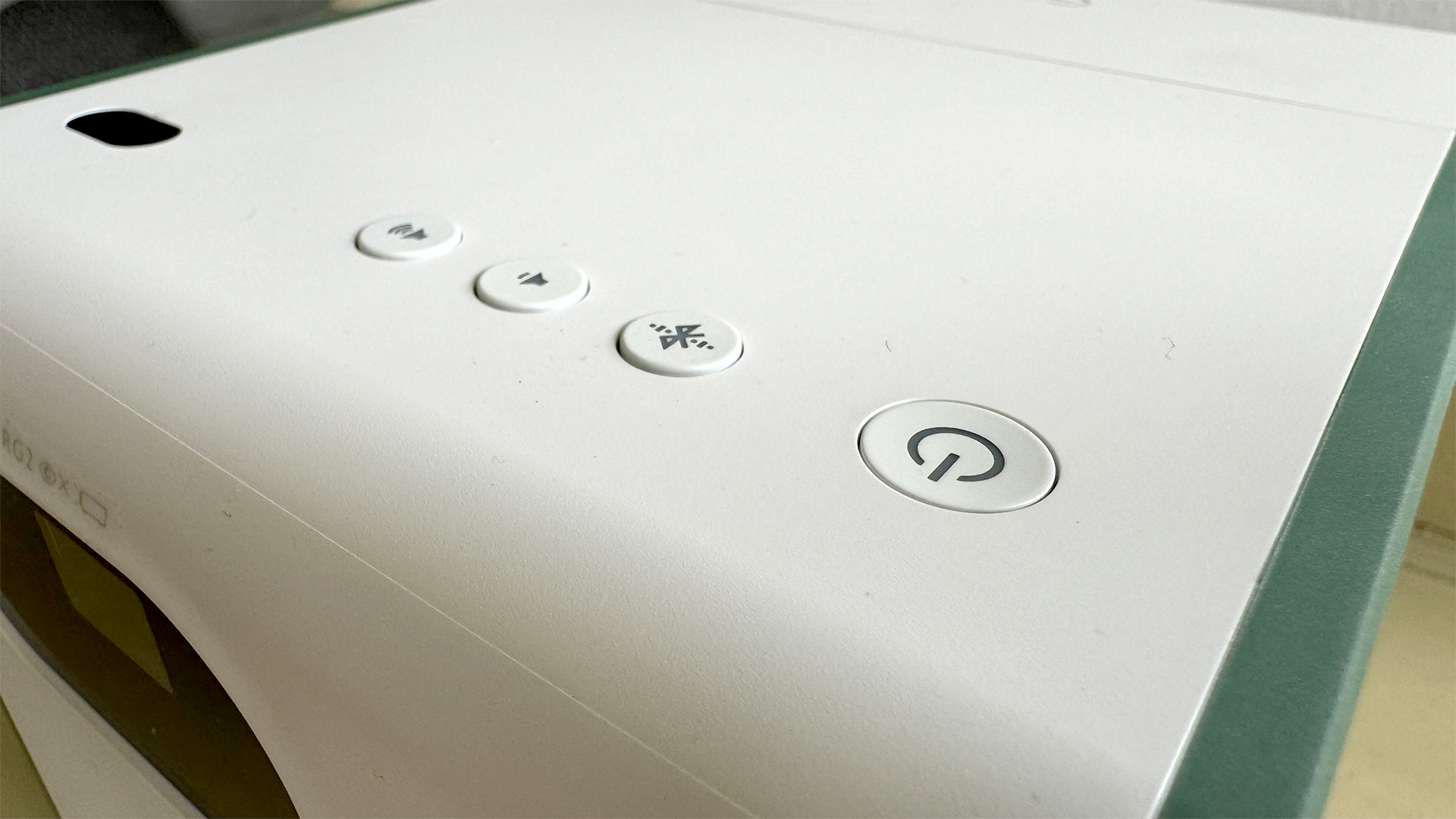
The BenQ GS50’s £699 / $699 / AU$1450 asking price looks quite high for a portable projector. It’s more expensive, for instance, than the recently reviewed Nebula Mars 3 Air. It’s the same price, too, as the Samsung The Freestyle portable projector, with its distinctive barrel-in-a-rotating-cradle design and versatile usage scenarios.
So while it’s not completely ‘out there’ in pricing terms, the GS50 will certainly have to deliver the performance goods to justify its money against such potent competition.
Design
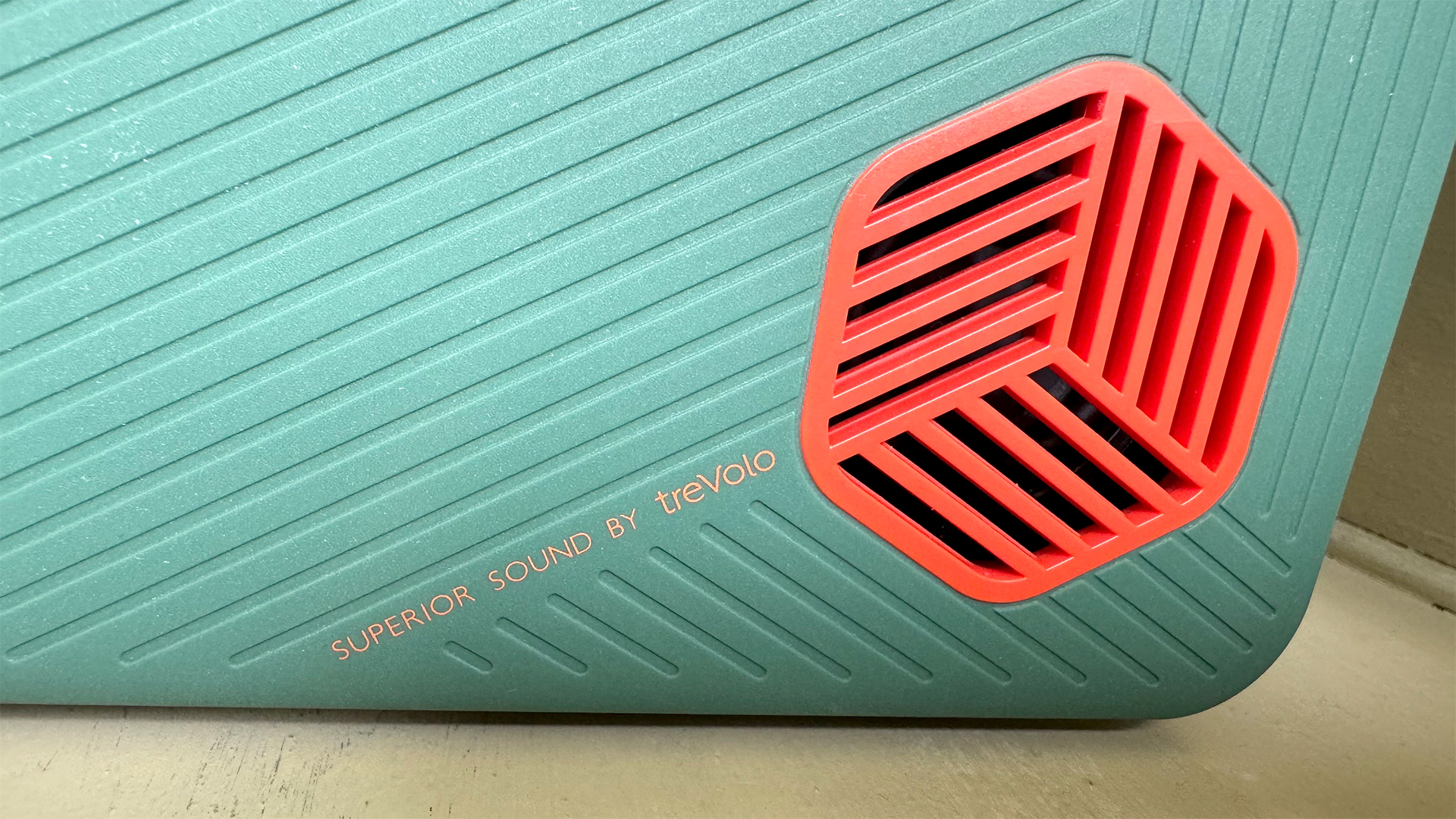
The BenQ GS50 starts to justify its price in fine style with its design. For starters, it’s fantastically well-built. There’s real heft to it when you pick it up by the strap attached to its left-hand side, and the bodywork feels rugged and solid on every side. In fact, the GS50 is double protected by a 1mm-thick Thermoplastic polyurethane (TPU) inner layer and drop-proof outer resin, which BenQ says means it could survive being dropped from a height of 70cm (more than two feet in old money). Very handy for klutzes like us.
It’s also protected with splash-proof film to the IPX2 standard, meaning it can withstand light splashes, and it incorporates channels into its left and right sides to help liquids run away from the projector’s important bits. BenQ’s website even shows a photo of the projector operating in what appears to be a bit of mizzly rain.
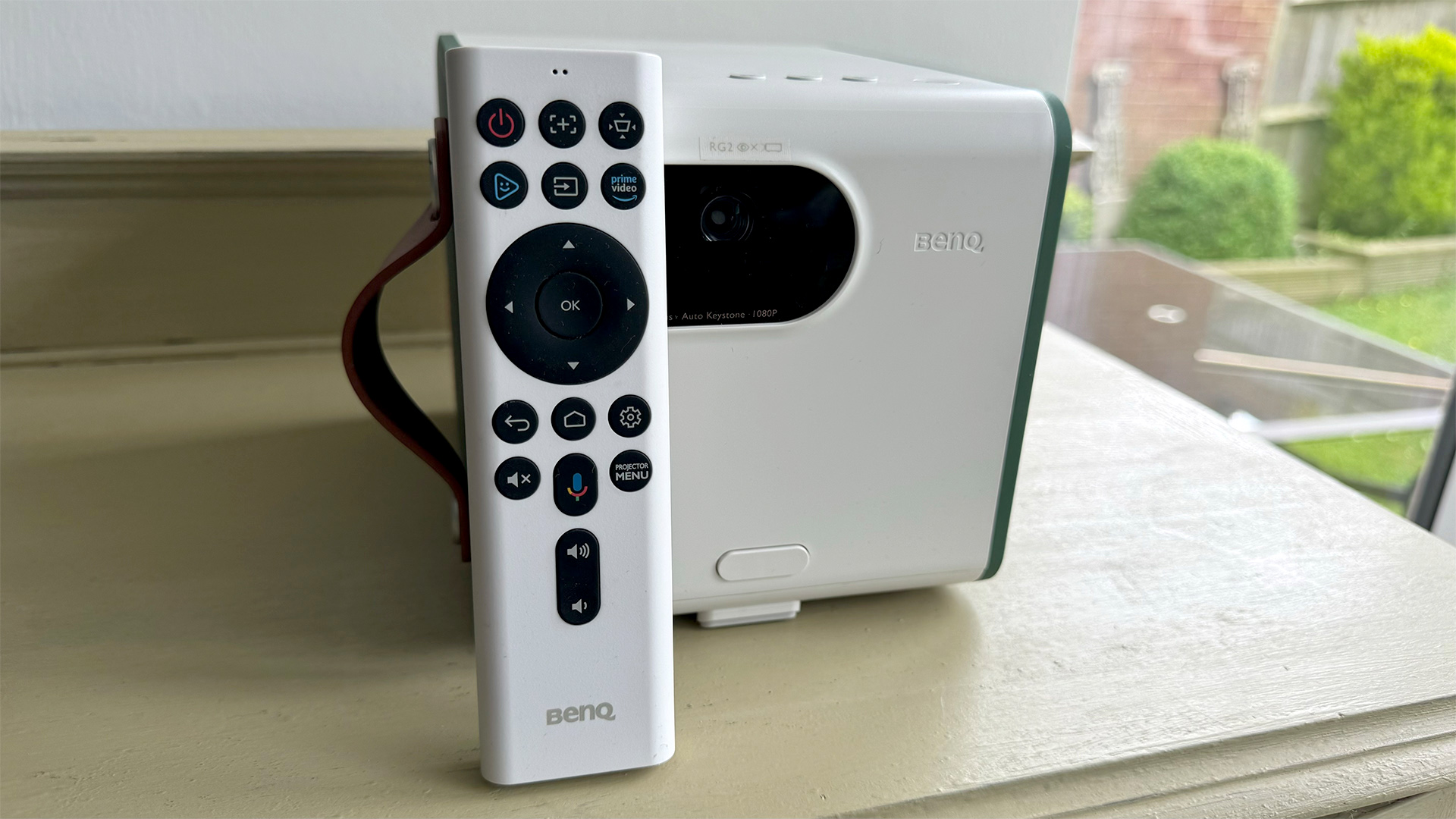
Projector type DLP LED
Processing Auto set-up, CinematicColor technology
Screen size 30-100 inches
Native resolution 1080p
Input lag with 60Hz 22ms
HDR support HDR10, HLG
Dimensions 15 x 19 x 15cm
Weight 3.9kg
The GS50’s extremely distinctive combination of cream-coloured main bodywork, mid-green sides, orange hexagonal speaker port covers and deep tan carry strap also gives the projector an outdoorsy, natural feel a million miles from the usual dull black or white boxes most projectors are housed in.
Power and volume buttons are provided on the GS50’s top edge, while connections – a rear-mounted DC input and side-mounted AV ports – are all placed under removable rubberised covers to support the projector’s splash-proof rating. The connections comprise an HDMI 2.0 port, a type A USB port for USB readers, a USB-C supporting DisplayPort Alt Mode and power delivery, and a 3.5mm audio line out.
The GS50 ships with a mid-sized remote control boasting a crisp white finish and large, clearly-labelled buttons. There’s no backlighting for the buttons, but then we guess BenQ sees the GS50 being used in lighter environments than most projectors tend to be.
Features
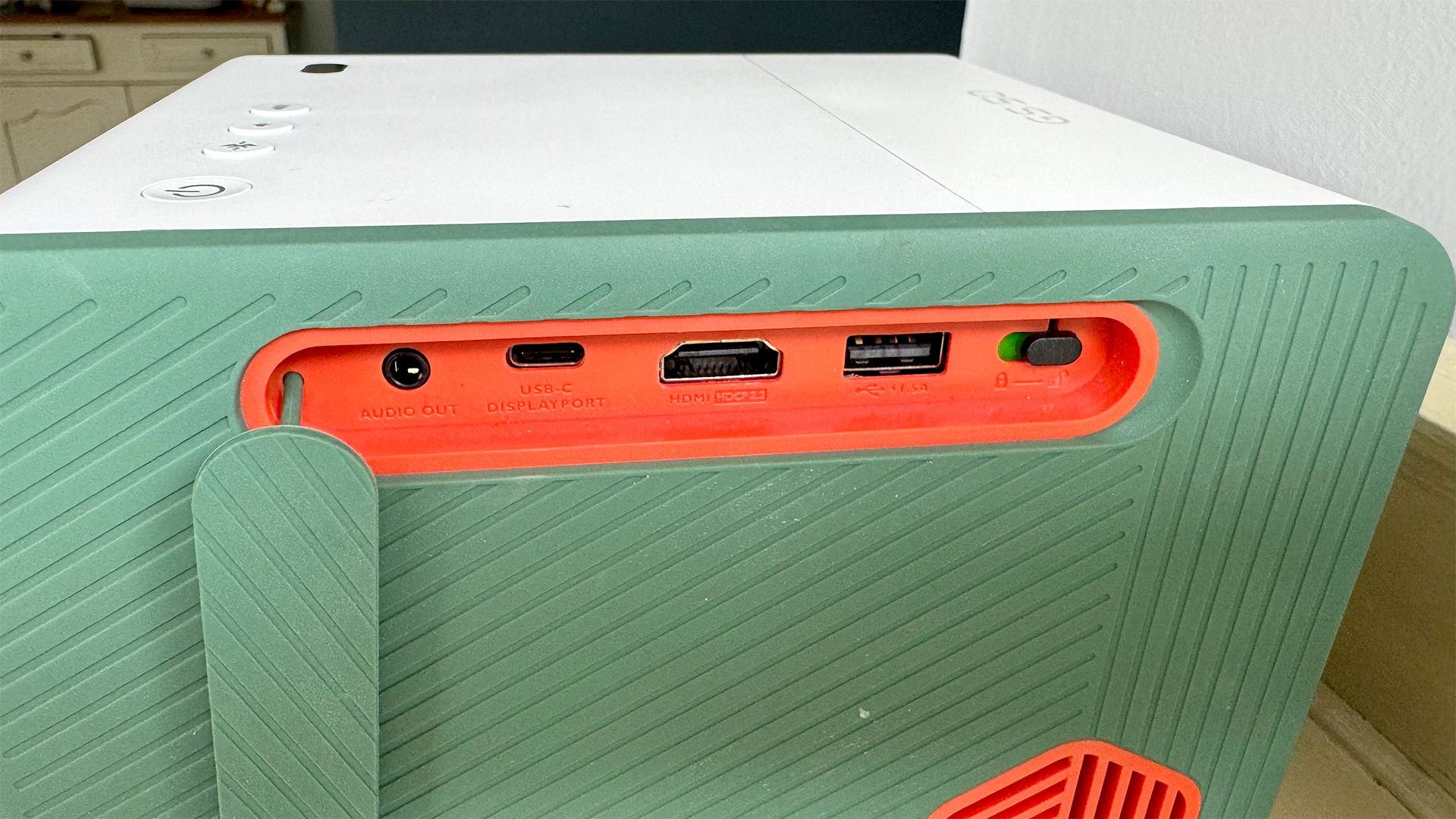
Tucked inside the GS50’s compact but rugged form is a Full HD DLP optical system illuminated by LED lighting capable of delivering a lifespan of 30,000 hours and up to 500 lumens of brightness. This is a high brightness claim for such a portable projector – 25 per cent higher, in fact, than the brightness claimed for the already punchy Anker Nebula Mars 3 Air.
Despite being brighter than the Mars 3 Air, the GS50 is rated by BenQ as only being able to comfortably support a 100-inch maximum image size. This seems to us like simply a healthy bit of common sense from BenQ’s specifications department, though, as in reality the Nebula Mars 3 Air looks too dull for comfort once you push it past 90 inches or so, despite its 120-inch maximum image size claim.
While the GS50 only carries a Full HD DLP engine, it can actually take in 4K sources. This might sound a bit pointless, but actually it downscales 4K sources well enough to make them look arguably a bit crisper and cleaner than native HD images tend to.
There’s also support for the HDR10 and HLG HDR formats, with BenQ joining the recently tested Anker portable projector in claiming support for 90 per cent of the DCI P3 HDR colour spectrum.
Projectors truly focused on portability should be easy to set up, and the GS50 doesn’t let us down. A simple drop-down foot under the front edge lets you angle the projector’s image to where you want it to appear, while auto focus and auto keystone correction ensure the picture’s sides are perpendicular and the image looks sharp without you having to get involved with any manual intervention. There’s even an ambient sensor that enables the GS50 to adjust its pictures in response to the amount of ambient light around – which is, of course, particularly handy for a projector capable of working outside.
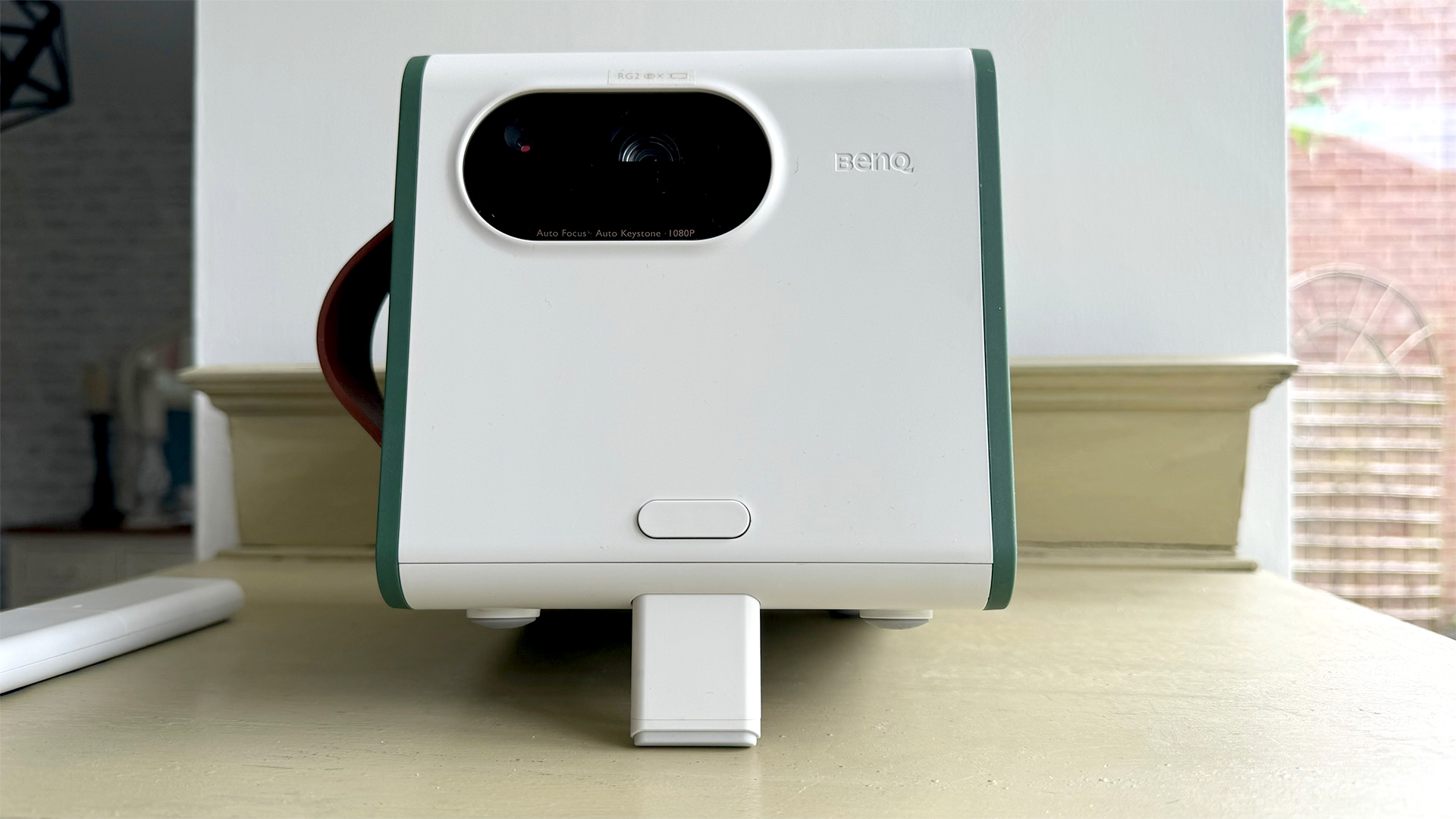
Truly portable projectors, especially those with an eye on outdoor use, also need to be able to work without mains power. The GS50 has this covered, too, with a built-in battery claimed to deliver up to 150 minutes of video playback, or 360 minutes of music playback if you fancy using the projector as a portable speaker.
This potential use is backed up by an unusually powerful-sounding speaker array of two 5W drivers and a 10W bass woofer. What’s more, the way the cabinet is designed allows the GS50’s sound to emerge across a 270-degree spread, and there’s even a built-in DSP chip that’s claimed to optimise playback of different music genres.
The GS50 supports Bluetooth (4.2), wi-fi, Miracast and both Airplay and Chromecast, making it easy to mirror or stream content from phones and tablets. You can also control the projector via your phone or tablet courtesy of the BenQ Smart Control app.
There’s no support over the GS50’s HDMI input, though, for advanced gaming features such as 4K/120Hz or VRR. What’s more, our initial measurements of the GS50’s input lag hit a disappointing 90ms+, which is way more than the 22ms BenQ claims in the GS50’s specifications. Eventually, after much discussion with BenQ, it turns out that the GS50 can hit 22ms of lag, but only if you’re running firmware v01.00.17.00 or newer, have the projector’s Keystone and Corner Fit correction features both set to zero, and are feeding the projector an exact 1920x1080 signal.
The GS50 ships with an Android TV dongle included in the box, giving you most of the streaming apps we’ve come to expect from the Android TV platform. There’s support for Google Assistant voice control, too, via a mic in the remote controls.
Netflix isn’t present as standard, though, since the streamer hasn’t officially certified an app for BenQ/Android TV use. Also, while Disney+ and Apple TV+ both recognise the projector as HDR capable, the Prime Video app does not. As ever with Android TV, moreover, there’s no sign of the BBC iPlayer, All4 or Freeview Play apps popular with UK households.
If you’re thinking, finally, that the GS50 sounds like a potentially great option for the kids to use, you might be pleased to know that as well as being drop-proof from child-carrying heights, the projector can be set to turn off its light if an approaching object – such as an inquisitive child – gets within 30cm of the lens.
Picture
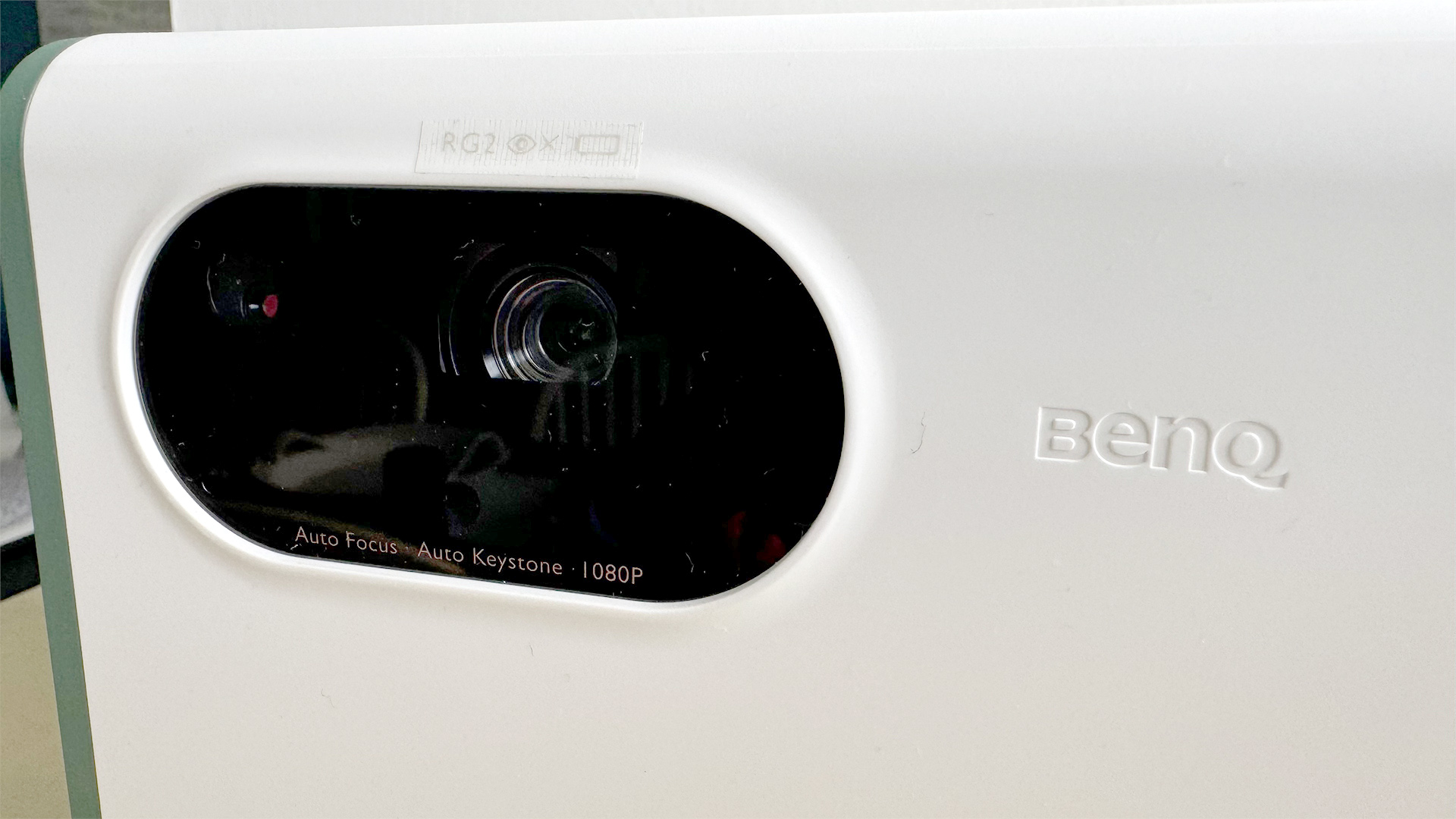
While there are some good things about the GS50’s pictures, there are a couple of pretty major issues that ultimately prove hard to see past. Let’s deal with these first.
The main one is that the GS50’s black levels with high dynamic range content are really quite poor. Dark HDR scenes sometimes look so washed out with low-contrast greyness, in fact, that it actually becomes impossible to see what’s happening. When Georgie heads into the cellar near the start of It, for instance, you literally can’t see anything but greyness during the very darkest shots. The suspense becomes more to do with when you might actually be able to see any picture information again rather than what’s actually going on in the film.
It doesn’t help the HDR black level situation, either, that the overwhelming greyness features a slight red tone, taking the projector even further away from the neutral black hues you should be seeing.
The other big problem is some freakishly bad motion handling if you’re watching a 24p movie – regardless of whether it’s via the GS50’s built-in apps or external sources. Camera pans or objects moving across the scene cause a really unnatural, distracting, staccato juddering effect, almost as if you’re playing a video game on a higher frame rate setting than your PC is capable of handling properly. This is obviously at its most distracting with action movies but, honestly, it makes even kitchen sink dramas look awkward at times. And we weren’t able to find any processing or other settings that dealt with this problem.
Even 60Hz frame rates don’t look quite right on the GS50; there’s still a slightly uneven, processed feel to objects moving across the screen.
The BenQ GS50’s main strength is its brightness by portable projector standards. This is something of a double-edged sword given that it doubtless contributes to the projector’s issues with handling dark scenes, but bright HDR content unquestionably looks punchy, bold and richly saturated. More like HDR, in fact, than it does on the Anker Nebula Mars Air 3. It’s just a shame that the GS50 can only handle the bright end of the HDR light spectrum, showing precious little interest in the dark end.
The GS50’s brightness also, crucially, helps it punch through ambient light more successfully than most portable projector rivals. In fact, this is – as you might expect of a projector that clearly pushes its ‘outdoor’ potential – by far the GS50’s most appealing performance trait. We’re not sure any projector will ever outgun bright sunlight, but in the more overcast conditions or long dusks of the typical British summer, or the more controllable ambient light levels you get in typical living rooms, colours retain fuller saturation and subtle details remain more visible, at least in bright scenes, via the GS50 than they do on pretty much any other portable projector we can think of.
The GS50 doesn’t suffer with DLP’s rainbow effect as much as we’d feared such a bright portable projector might, either, and it should be stressed that the sort of relatively bright conditions to which BenQ sees the GS50 as ideally suited disguise the worst of the projector’s black level limitations. However, the GS50’s lack of any real native contrast does mean that the Anker Nebula Mars 3 Air can still look more dynamic, if not all-round brighter, in moderately bright conditions due to its much better native contrast.
The GS50 also impresses with its sharpness. HD and especially 4K sources look detailed, textured and crisp, without exaggerated noise, grain or edge enhancement. This sharpness, together with the reasonably high brightness, means it can drive a bigger image without that image becoming too dull than most portable projectors can. Up to 100 inches, we’d say, in a fairly dark environment, before the image starts to look too soft or dull.
Finally, as with many affordable or portable projectors, the GS50 works slightly better as an SDR projector than an HDR one. Its SDR pictures still look slightly brighter than SDR pictures do on most portable projectors, but at the same time, its dark scenes look slightly more convincing. Though still not enough to become really satisfying in any remotely dark environment.
Sound
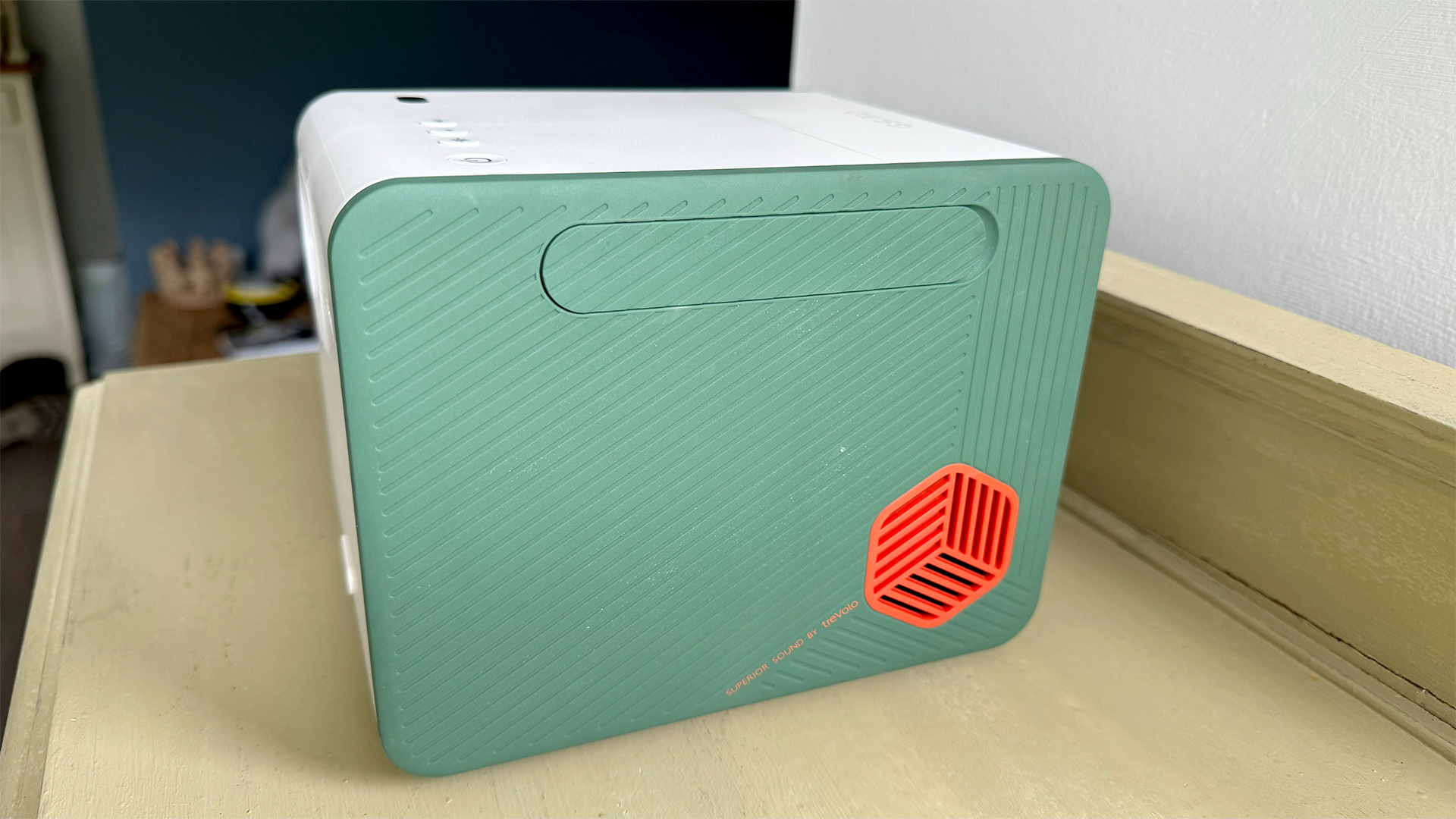
The GS50’s sound is actually much more flexible than its pictures, in that it proves just about as usable for music as it is for movies.
For starters, its genuine stereo configuration, with drivers firing out of its left and right sides, helps its sound enjoy both a better sense of separation and a larger soundstage than we often hear with projectors, especially portable ones. If you’re using the projector inside, the sound fills the space in front of you really quite effectively, making the soundstage feel in scale with the large visuals. Outside, the power and throw distance of the sound means it retains clarity and impact within a larger seating ‘hemisphere’ before the sound is lost in the wind.
The GS50's scale, but also control, of audio enables it to craft even complex film soundtracks into effective layers of sound, as well as create a quite sophisticated sense of three-dimensional space where a mix contains enough subtle detail to make such a defined sense of space possible.
Aside from the occasional really deep male voice sounding a bit dense and ‘soupy’, vocals delivered via the GS50 actually sound nicely rounded and convincing – as if they’re being delivered by actual humans rather than some computer-generated voice box. The rounded tone carries across the whole of the GS50's sound, in fact, ensuring that it doesn’t start to feel harsh or thin even when a film soundtrack is pushing it hard.
There’s even a reasonable amount of bass to be heard rumbling along beneath the main action, giving action scenes more heft, impact and authenticity than the vast majority of other portable projectors manage.
This GS50’s bass shifts from drones and rumbles to punchy and well-timed bass lines for music playback too, joining the impressive stereo separation and some surprisingly clean, convincing and well-positioned vocals in making music quite easy to listen to. We’re not suggesting that the GS50’s music performance is a rival for a good dedicated portable speaker. Especially a good £699 / $699 / A$1450 dedicated portable speaker. But it’s more credible than the music we’ve heard from any other portable projector to date.
There are a couple of niggles, of course. One is that in carefully locking dialogue at the heart of its soundstage, the GS50 can leave dialogue sounding a little too trapped in the projector, rather than throwing it forward so that it seems to be coming from the onscreen action. Also, the mostly impressive bass performance can push a bit too hard at times, causing mild distortions with the most extreme movie bass moments. These are both minor issues by projector audio standards, though.
Verdict
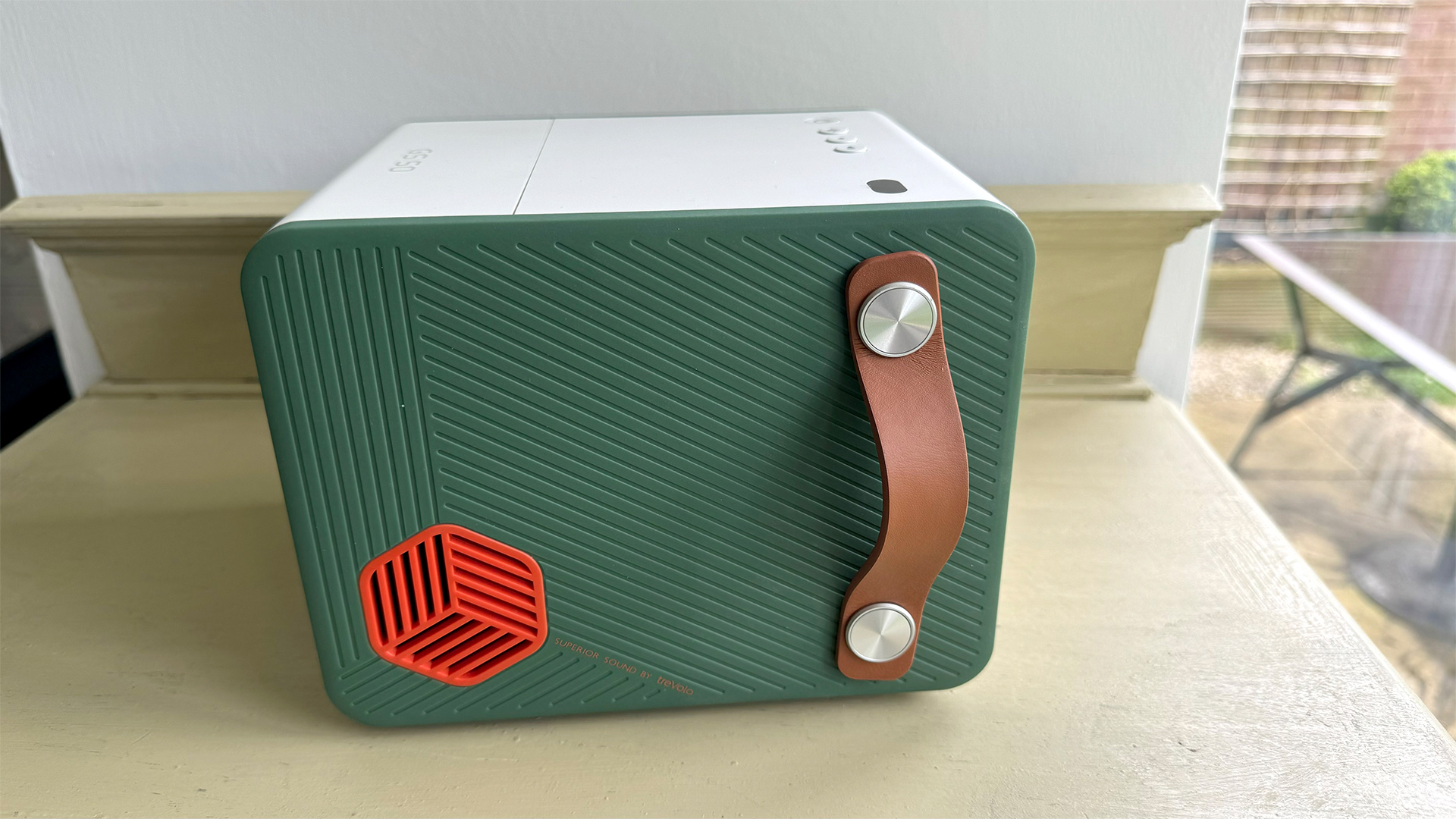
The GS50 is attractively and robustly designed, and it produces much better sound than most portable projectors. Also, in the specific outdoor environments that they’ve clearly been tuned for, the GS50’s pictures do hold up a little better than those of most portable projectors. The GS50’s inability to adapt its images satisfactorily to interior viewing, though, especially in any remotely darkened room environment, makes it more of a one-trick pony than we suspect many of our readers might like it to be – especially given the premium price and, particularly in the UK, how rarely they’ll likely be able to enjoy its one trick, thanks to the Great British weather…
SCORES
- Picture 2
- Sound 4
- Features 4
MORE:
Read our review of the Anker Nebula Mars 3 Air
Also consider Samsung's The Freestyle
Best projectors: our pick of the top options







